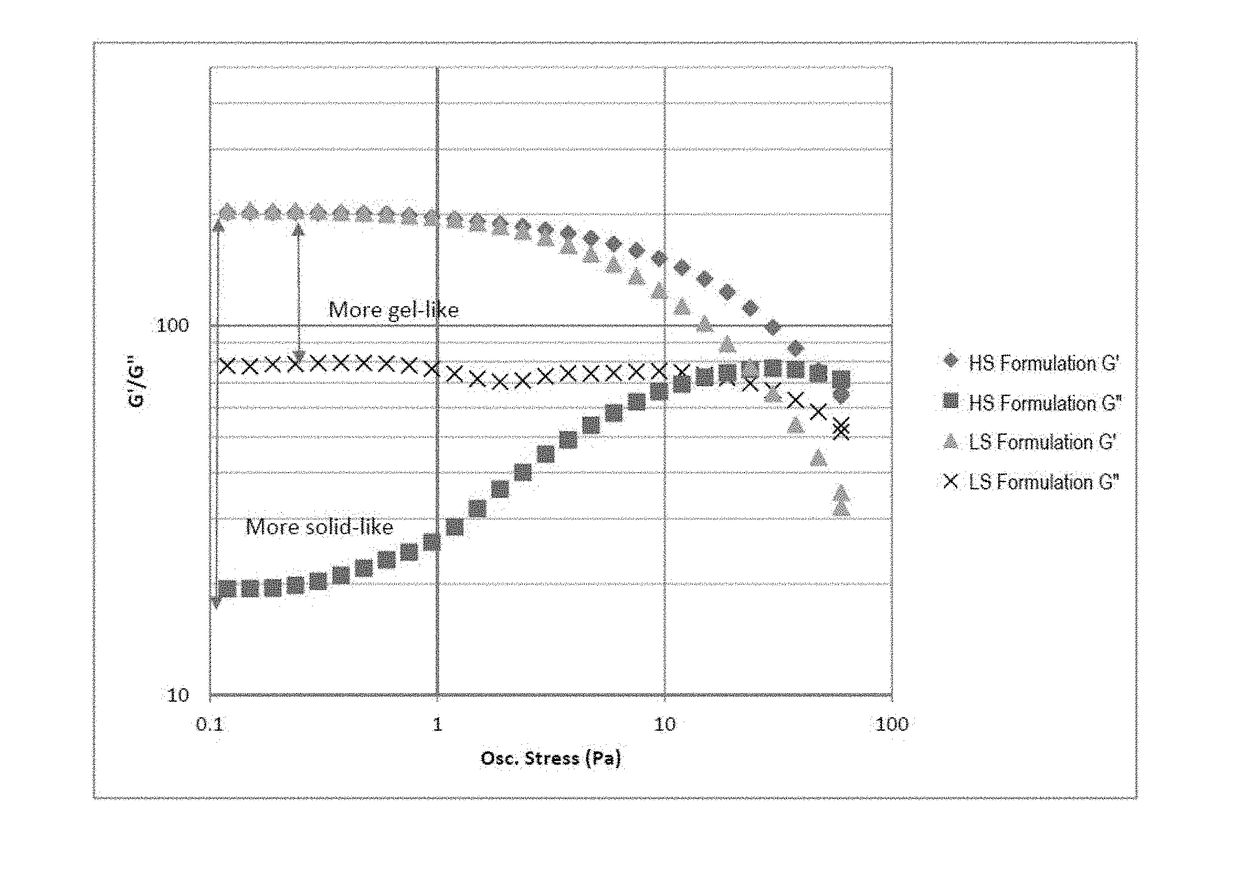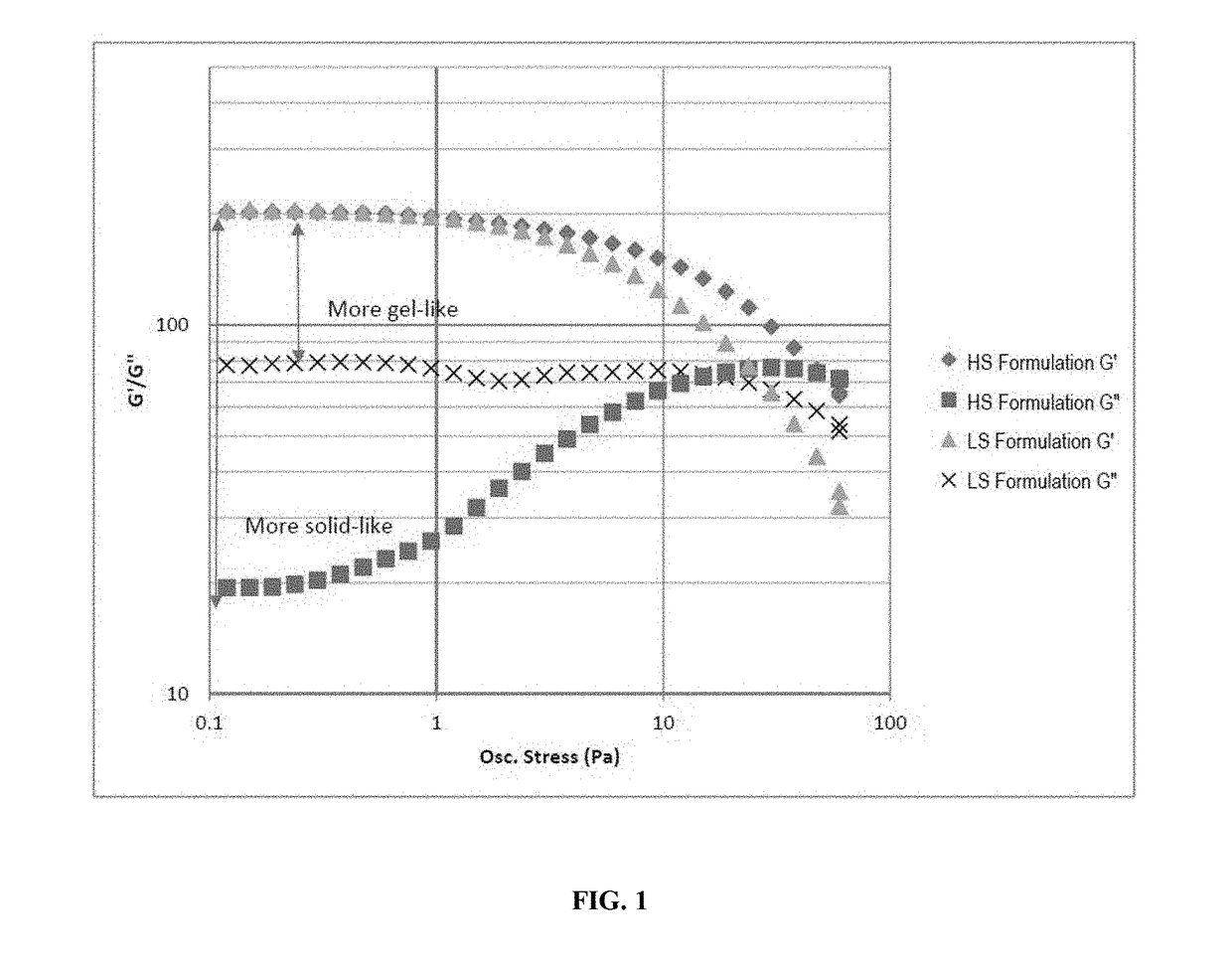Stable unit dose compositions with high water content
a unit dose composition and high water content technology, applied in the direction of surface-active detergent compositions, non-ionic surface active compounds, detergent compositions, etc., to achieve the effect of unit dose pacs, high water content, and high activity
- Summary
- Abstract
- Description
- Claims
- Application Information
AI Technical Summary
Benefits of technology
Problems solved by technology
Method used
Image
Examples
example 1
ivity of Sodium Chloride Solution
[0158]By utilizing water binding agents such as salts (i.e. sodium citrate or sodium chloride), the water activity of a high water product can be reduced to 0.9 or below to create stable unit doses (e.g. pacs). For example, the following solutions were made and their water activity were measured at 25° C. using an Aqua Lab 4TEV DUO (a water activity meter) on the capacitance setting.
SolutionWater activityDeionized (DI) water1.010% sodium chloride in DI Water0.9416% sodium chloride in DI Water0.922% sodium chloride in DI Water0.86
[0159]When creating single dose pacs with a PVOH water-soluble film, the 10% sodium chloride solution ruptured immediately due to its high water activity. However, the 16% and 22% sodium chloride solutions can be incorporated into pacs and properly sealed. Additionally, the 22% sodium chloride solution created a much more rigid, stable pac and was not as elongated (i.e. 2.5 inches long for 16% versus 2 inches long for 22%). P...
example 2
t Systems with Sodium Chloride
[0160]Solutions of 16% and 22% sodium chloride solutions were created with and without surfactant (TOMADOL 25-7 nonionic and / or Alcohol Ethoxysulfate (AES)) to mimic a detergent product. Total water level of pacs with surfactants was 55 to 72%. All pacs showed stability during the pac making process, with the pacs containing the 22% NaCl solution having superior rigidity as compared to the 16% NaCl solution. Visually, it showed that incorporating surfactants improved the pac stability by enhancing rigidity.
Type of NaCl Solution:16%22%16%16%22%22%16%22%Total Surfactants0%0%15%20%15%20%30%30%Water (% wt)847871.467.266.362.458.854.6Sodium162213.612.818.717.611.215.4Chloride(% wt)TOMADOL001510010151525-7 (% wt)AES (% wt)0001015101515Total (% wt)100100100100100100100100
example 3
Surfactant Systems with Added Salt
[0161]Initial work focused on surfactant systems to study the role that total surfactant and total added salt (for example, sodium chloride, sodium sulfate, trisodium citrate) played in pac compatibility.
TABLE 1Fomulation of a lamellar surfactant system.WeightActivity %Active %%DI Water1002727Citric Acid (50%)503.456.9NaOH (50%)502.75.4Sodium Chloride1003.163.16TEA (85%)852.643.1LAS966.036.29Cocofatty Acid1001.721.72Alcohol Ethoxylate6013.7922.99TOMODOL 25-710023.4523.45Total100Total Surfactant45Total Water39.94
[0162]The lamellar surfactant system prepared according to Table 1 was placed into a pac. The formula contained and 45% total surfactant and almost 40% total water. The total surfactant is composed of LAS, cocofatty acid, alcohol ethoxylate, and TOMODOL 25-7. The total water amount includes added DI water and water present in other materials, such as 50% citric acid and 50% NaOH. Despite the high water amount, the pac survived the pac making ...
PUM
 Login to View More
Login to View More Abstract
Description
Claims
Application Information
 Login to View More
Login to View More - R&D
- Intellectual Property
- Life Sciences
- Materials
- Tech Scout
- Unparalleled Data Quality
- Higher Quality Content
- 60% Fewer Hallucinations
Browse by: Latest US Patents, China's latest patents, Technical Efficacy Thesaurus, Application Domain, Technology Topic, Popular Technical Reports.
© 2025 PatSnap. All rights reserved.Legal|Privacy policy|Modern Slavery Act Transparency Statement|Sitemap|About US| Contact US: help@patsnap.com



